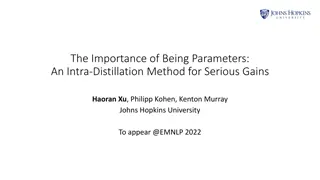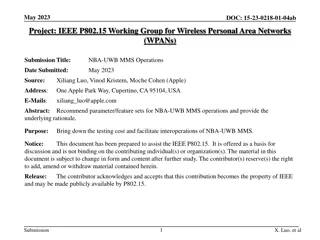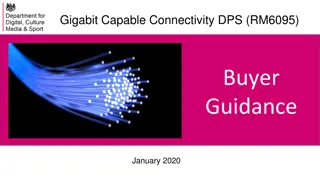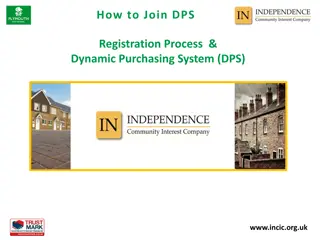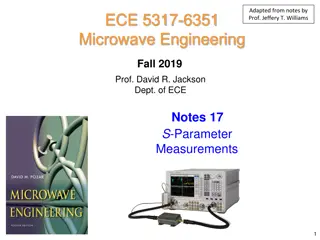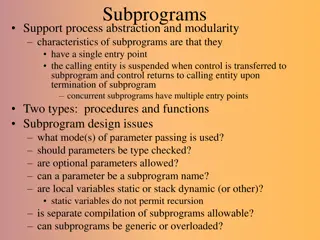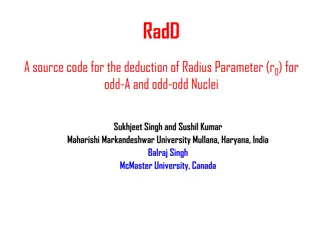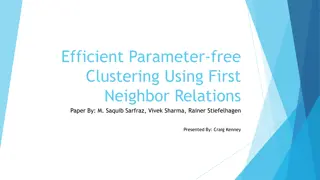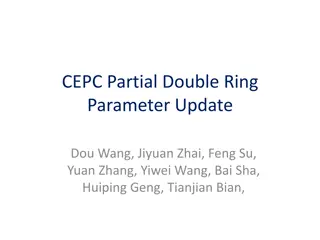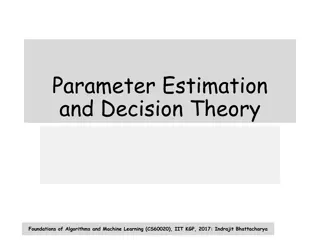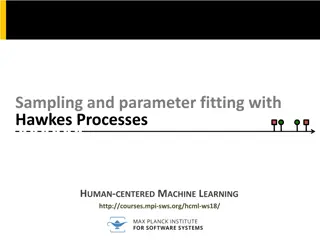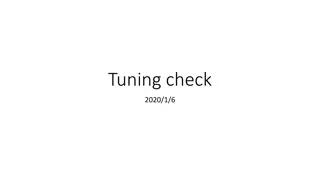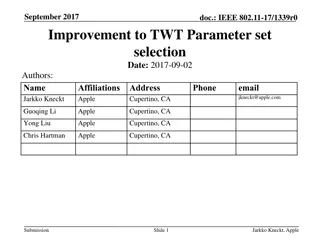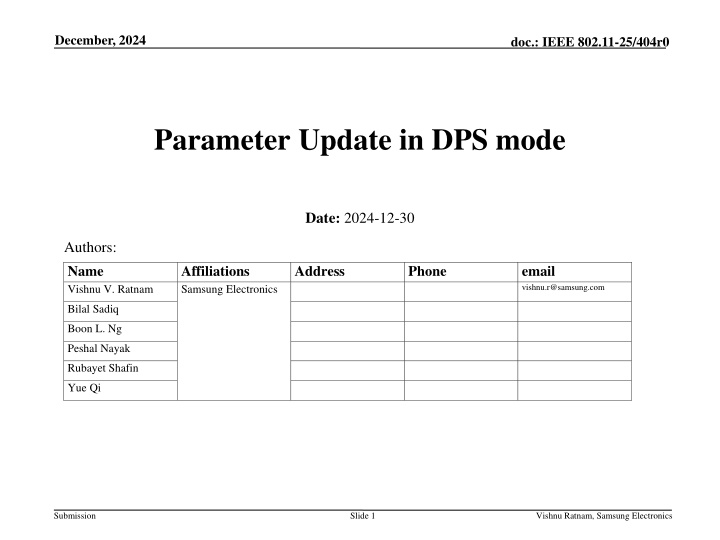
IEEE 802.11 DPS Mode Parameter Update in December 2024
Discussing mechanisms for a STA operating in Dynamic Power Save (DPS) mode to indicate and update its DPS parameters, including how updates can be indicated by an AP and a non-AP STA in IEEE 802.11 standard.
Download Presentation

Please find below an Image/Link to download the presentation.
The content on the website is provided AS IS for your information and personal use only. It may not be sold, licensed, or shared on other websites without obtaining consent from the author. If you encounter any issues during the download, it is possible that the publisher has removed the file from their server.
You are allowed to download the files provided on this website for personal or commercial use, subject to the condition that they are used lawfully. All files are the property of their respective owners.
The content on the website is provided AS IS for your information and personal use only. It may not be sold, licensed, or shared on other websites without obtaining consent from the author.
E N D
Presentation Transcript
December, 2024 doc.: IEEE 802.11-25/404r0 Parameter Update in DPS mode Date: 2024-12-30 Authors: Name Vishnu V. Ratnam Affiliations Samsung Electronics Address Phone email vishnu.r@samsung.com Bilal Sadiq Boon L. Ng Peshal Nayak Rubayet Shafin Yue Qi Submission Slide 1 Vishnu Ratnam, Samsung Electronics
December, 2024 doc.: IEEE 802.11-25/404r0 Abstract This document discusses mechanisms for a STA operating in Dynamic Power Save (DPS) mode to indicate and/or update one or more of its DPS parameters. Submission Slide 2 Vishnu Ratnam, Samsung Electronics
December, 2024 doc.: IEEE 802.11-25/404r0 Introduction To allow a STA to save power dynamically without degrading the latency and throughput performance of UHR devices, Dynamic Power-Save (DPS) mechanism was proposed in 11- 23-10r0 [1]. A STA in DPS mode operates in a low power state (low capability state) by default to save power. It transitions to a high power state (high capability state) on demand, after receiving an initial control frame (ICF) from the TXOP owner. The STA may remain in the high power state for the duration of the TXOP. For example, low power state: 20MHz and 1 NSS, and high power state: 160MHz, 4 NSS. By initiating a transmission with an ICF, a peer STA that supports DPS can reap the benefits of the full capabilities of the DPS STA for the duration of the TXOP. Low-power state Low-power state High-power state Frequency ICF (padding) Uplink PPDUs (padding) ICF (padding) Resp. frame ACK Time DPS Transition Delay DPS Padding Delay Submission Slide 3 Vishnu Ratnam, Samsung Electronics
December, 2024 doc.: IEEE 802.11-25/404r0 DPS mode parameters A STA operating in DPS mode may have several associated parameters: An indication of whether the DPS mode is enabled or disabled. Applicable delays: DPS Padding delay and DPS Transition delay. Capabilities in the high-power state (BW, NSS, locations of secondary channels, MCS, PPDU versions) etc. Capabilities in the low-power state (BW, NSS, locations of secondary channels, MCS, PPDU versions) etc. Indication of periods where DPS STA operates in the high-power state by default. (see slide 9) Some of these parameters may also be updated over time. In this contribution: We first discuss how updates to DPS mode and updates to DPS parameters can be indicated by an AP and a non-AP STA. We next discuss how some of the currently used DPS parameters at an AP can be indicated. Finally we discuss how some of the aforementioned DPS parameters can be encoded. Submission Slide 4 Vishnu Ratnam, Samsung Electronics
December, 2024 doc.: IEEE 802.11-25/404r0 DPS update indication Before the DPS mode or its parameters are updated at AP or non-AP STA, the updates are indicated in: Option 1: A new element -- DPS Parameters element Option 2: Field of an existing element, e.g., UHR Operations element, ML Reconfiguration element, etc. This element/field is transmitted by the AP in Beacon frames and Probe Response frames, while the update is scheduled. This element/field is transmitted by the non-AP STA in the UHR Operating Mode Notification frame. The DPS Parameters element/field includes: DPS Mode field which indicates whether DPS mode is being enabled, disabled, or DPS parameters are updated (while remaining enabled). A Start Time field counts down to the TBTT at which the indicated update takes effect. The Updated DPS Parameters field is present when the Start Time field is set to a non-zero value and DPS Mode is set to either Enable or ParameterUpdate . It includes all DPS parameters. When transmitted by an AP, the update is applicable when the scheduled start time has elapsed. The AP should include the DPS Parameters element/field sufficiently in advance of the start time, to ensure all associated STAs are able to receive the indication before the update is applicable. Submission Slide 5 Vishnu Ratnam, Samsung Electronics
December, 2024 doc.: IEEE 802.11-25/404r0 DPS update indication contd. When transmitted by a non-AP STA, the update is applicable upon receiving a corresponding response frame. (similar to EMLSR) The Start Time field is set to 0 or is reserved or not present for a Non-AP DPS STA. After the scheduled update takes effect, the DPS Parameters element/field is included in Probe Response frames while DPS mode is enabled at the AP, but is not included in Beacon frames. DPS Mode Description 0 DPS Disable DPS Parameters element/field 1 DPS Enable* DPS Mode Start Time Updated DPS Parameters Other fields 2 DPS Param Update* Bits: 2 6 0 or variable 3 Reserved Order Information 1 Category 2 Protected UHR Action 3 Dialog Token Inclusion in Beacon frame, Probe Response frames. 4 DPS Parameters *Note: It is TBD if separate modes are needed for DPS Enable and DPS Param Update . Submission Slide 6 Vishnu Ratnam, Samsung Electronics
December, 2024 doc.: IEEE 802.11-25/404r0 Current DPS parameter indication by AP While an AP is operating in DPS mode, it may periodically indicate some of the currently operational DPS parameters in Beacon frames. It is TBD which parameters are to be included, e.g., DPS Enabled, Default DPS State (see slide 8), etc. Option 1: These parameters are indicated in the UHR Operations element of the Beacon frame. UHR Operations element Element ID Length Element ID Extension UHR Operation Parameters Basic UHR-MCS And Nss Set UHR Operation Information Other fields Current DPS Parameters Other fields DPS Enabled Option 2: These parameters are indicated in the DPS Parameters element (defined in slides 5-6) of the Beacon frame, i.e., it indicates both current DPS parameters and updates. The Current DPS Parameters field indicates some of current parameters when DPS is enabled. The field is reserved/not present when transmitted by a non-AP STA. DPS Parameters element Element ID Length DPS Mode Start Time Updated DPS Parameters Current DPS Parameters Bits: 8 8 2 6 0 or variable 0 or variable Submission Slide 7 Vishnu Ratnam, Samsung Electronics
December, 2024 doc.: IEEE 802.11-25/404r0 Indication of high-power state periods for AP An AP in DPS mode may continue operating in the high-power state for an extended duration, without returning to the low-power state (the default state in DPS). This may be done if the AP determines that the channel utilization is too high, traffic buffer size is too large, expects many DPS ICFs after DTIM beacons, etc. Note: It is not preferred to transitioning out of DPS mode, since changing DPS mode is a slow process that requires prior indication by the AP for a sufficient period of time (see slide 5). The Current DPS Parameters indicated by the AP in Beacons (slide 7) can include: A Default DPS State field, that is set to 1 to indicate that AP will operate in high-power state for an extended time. The extended time can either be pre-determined, e.g., 1 TBTT, or the extended time can be indicated in a Default DPS State Duration field. A UHR STA that supports DPS and that has received an indication of the AP operating in high power state for an extended duration can directly initiate communicate with the AP as per the AP s high power state capabilities (without sending an initial control frame) during that duration. AP operates in high power state Current DPS Parameters Beacon Beacon Beacon Default DPS State Default DPS State Duration Other fields Submission Slide 8 Vishnu Ratnam, Samsung Electronics
December, 2024 doc.: IEEE 802.11-25/404r0 Conclusion When a DPS STA is updating its DPS mode or parameters, the updated parameters can be indicated in either (i) a DPS-specific element or (ii) field of an existing element. The advantage of defining a DPS-specific element is modularity, and ease of expansion in future Wi-Fi generations. The few additional octets for Element ID and Length fields is insignificant, since the indication is only provided when there is a DPS update scheduled. When an AP has DPS mode enabled, some currently operational DPS parameters can be indicated in the Beacon frames. As an example, a DPS AP may desire to stay in the high power state for an extended duration. In this case, the AP can indicate its current default DPS state and its duration, to allow UHR STAs to exploit this information. Submission Slide 9 Vishnu Ratnam, Samsung Electronics
December, 2024 doc.: IEEE 802.11-25/404r0 Summary AP behavior Non-AP STA behavior DPS update scheduled Indicate all updated DPS parameters in Beacon frames and Probe Response frames. Include all updated DPS parameters in a TBD Action frame. DPS enabled, no update scheduled. No signaling required. Include all DPS Parameters in Probe Response frames. Include some current DPS parameters in Beacon frames. Submission Slide 10 Vishnu Ratnam, Samsung Electronics
December, 2024 doc.: IEEE 802.11-25/404r0 References 1. 11-23-0010-00-0uhr-considerations-for-enabling-ap-power-save 2. 11-23-0015-00-0uhr-ap-mld-power-management 3. 11-23-0225-00-0uhr-considering-unscheduled-ap-power-save 4. 11-23-1835-00-00bn-ap-power-management 5. 11-23-1936-00-00bn-ap-mld-power-save-follow-up 6. 11-23-1965-02-00bn-dynamic-power-save-follow-up 7. 11-24-0451-00-00bn-ap-state-transitions-in-dps-mode Submission Slide 11 Vishnu Ratnam, Samsung Electronics
October, 2024 doc.: IEEE 802.11-25/404r0 Straw poll 1 Do you agree to define in 802.11bn a mechanism for a non-AP STA updating its DPS mode or DPS parameters to indicate the updates in a TBD Action frame transmitted by the non- AP STA. Yes No Abstain Submission Slide 12 Vishnu Ratnam, Samsung Electronics
October, 2024 doc.: IEEE 802.11-25/404r0 Straw poll 2 Do you agree to define in 802.11bn a mechanism for an AP updating its DPS mode or DPS parameters to indicate the updates in the Probe Response and Beacon frames, along with an indication of the start time at which the change is applicable. Note: The element where the updates are carried is TBD for e.g., a new DPS-specific element, UHR Operation element or the Reconfiguration ML element. Yes No Abstain Submission Slide 13 Vishnu Ratnam, Samsung Electronics
October, 2024 doc.: IEEE 802.11-25/404r0 Straw poll 3 Do you agree to define in 802.11bn a mechanism for a UHR AP that is operating in DPS mode to indicate some of its currently operation DPS parameters in Beacon frames. Note: It is TBD which parameters will be included and where they will be carried. Yes No Abstain Submission Slide 14 Vishnu Ratnam, Samsung Electronics
October, 2024 doc.: IEEE 802.11-25/404r0 Straw poll 4 Do you agree to define in 802.11bn a mechanism for a UHR AP that is operating in DPS mode to indicate in Beacons if it will operate in the high power state by default for an extended period. Note: It is TBD if the extended period is also indicated or is predetermined, for e.g., one beacon interval. Yes No Abstain Submission Slide 15 Vishnu Ratnam, Samsung Electronics
December, 2024 doc.: IEEE 802.11-25/404r0 Backup slides Submission Slide 16 Vishnu Ratnam, Samsung Electronics

